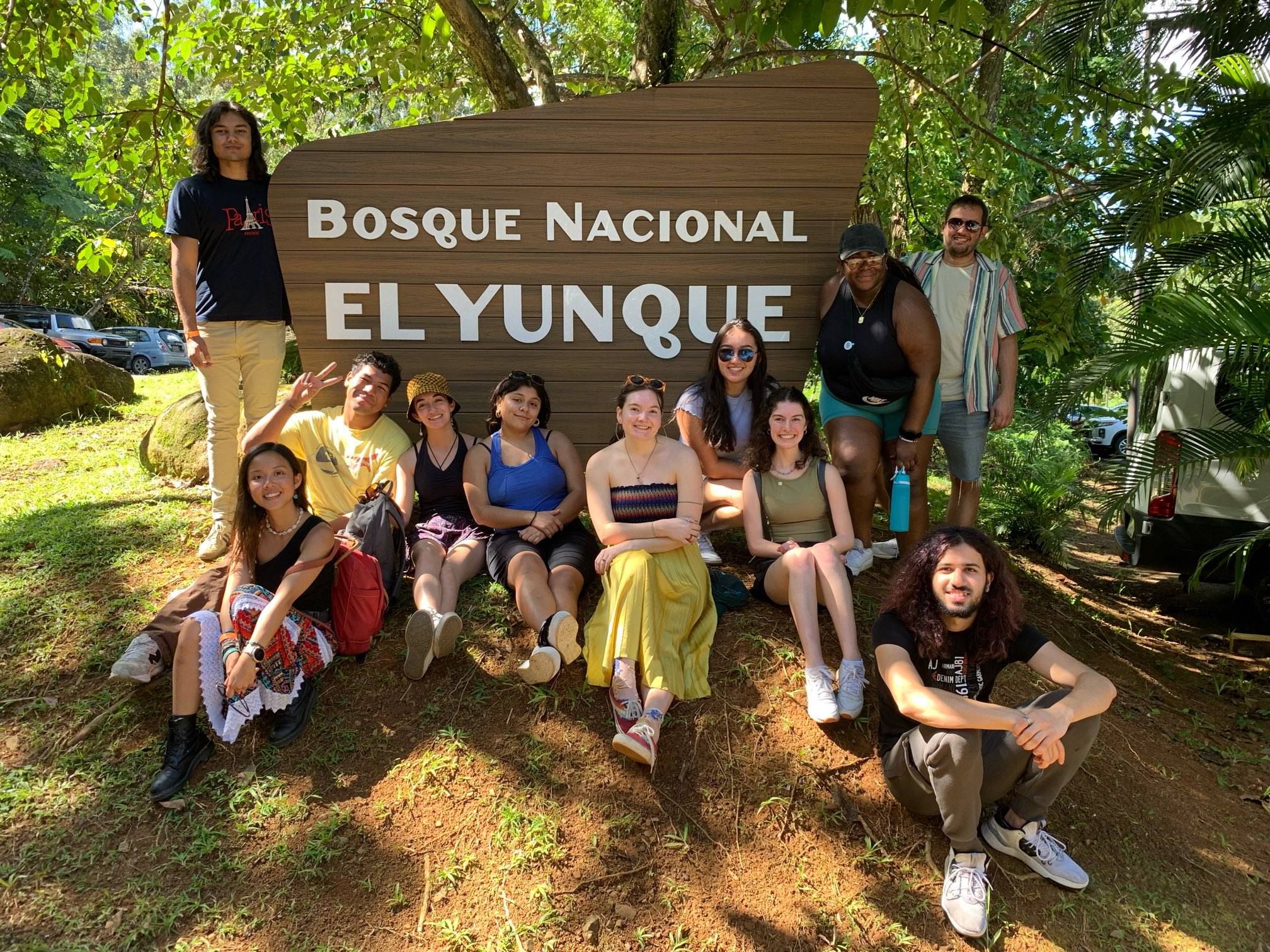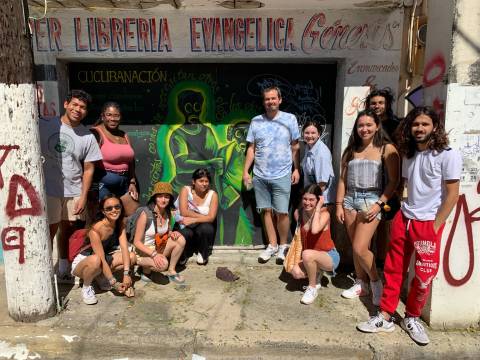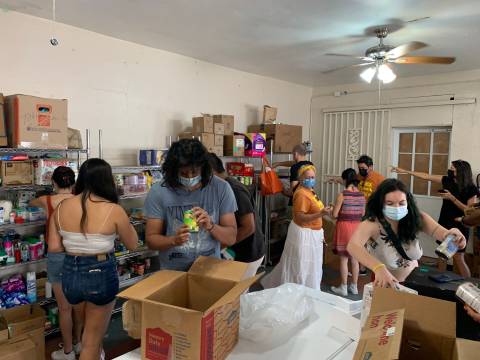It was a rare privilege to experience the land, culture, politics, and art of Puerto Rico with such a creative, diverse, ethical, and committed group of students.
The trip allowed us to observe firsthand the ways in which U.S. colonial policies are affecting Puerto Rico’s residents, ecologies, and foodways. However, the true learning experience was seeing how Black, Queer, and women-led decolonial movements are resisting through culture, art, literature, agriculture, dance, and mutual aid.
From plena music in Loiza to bomba dance in Mayagüez; from the colonial architecture of Viejo San Juan to the neocolonial gentrification of Santurce; from swimming in a bioluminescent bay in La Parguera to reflecting about Boricuas as a people who generate their own light in dark times through art at Cucubación — art, nature, and politics were everywhere entwined.
In Camp Tabonuco in Jayuya, we ate a meal harvested from the land and made watercolors with pigments from plants and earth taken from the same farm. We met with writers, such as Raquel Salas Rivera, whose work we studied on campus, and we met up with Prof. Villarrubia to volunteer with Brigada Solidaria del Oeste, a mutual aid organization of which she is a part. We also traveled overnight to New York City to see how Puerto Ricans in the diaspora are dealing with some of the same problems as those in Borikén.
The trip was transformative in every possible way. I can honestly say that we went there as a class, but by the time we departed we had formed friendships, indelible memories, and a caring, intellectual community.
Student Experiences
A Personal Connection through Art
I really liked the Bomba workshop. It showed me how powerful music can be and all the emotions it can convey. I liked how, in a way, it helped us all open up to one another, since I’m pretty sure that dancing isn’t our strongest point (for quite a few people). It was a different way of looking at music and that was quite impactful. Also just seeing the passion and the connection between Angel and Jamie [the instructors] really emphasized the importance of trust and comfort and communication, which are elements younger people seem to lack, especially in the fast-paced American culture where individualism and productivity appear to be the most important.
I also really liked the bioluminescent swim we had. It was magical and something that you have to experience to fully understand. It made me realize the beauty of our planet and how, due to our busy schedules nowadays, we spend too little time simply observing the small wonders surrounding us and marveling at the way they are.
Overall, I loved all the art workshops, from dancing to painting to making our own watercolors — they really opened my eyes to how I have prioritized work over my own hobbies. All the time spent dancing and painting didn’t feel like wasted time; instead, it felt like a moment in which tomorrow didn’t exist, and I could simply just relax and focus on the present. I felt connected to myself again through art.
So, overall, it was a very impactful trip, not only in terms of education, but also in terms of reconnection with myself.
— Thao Mai ’25
Finding Peace in Discovery
One of my favorite parts of the trip was the Cucubanación art workshop with Yasmin Hernández, and of course, the bioluminescent bay swimming that followed. Her space was incredible, and I felt like I was in my own little world while we were painting our portraits. That made the experience really meaningful. It was also very stress-free being able to just add color rather than draw something from scratch, and adding colors (light) onto the black canvas was beautiful.
Swimming in the bay was just so surreal. I was nearly emotional. Not only was being in the water cool, but taking the boat out to the bay is also a moment I remember very vividly just because of how silent we were. The breeze and the way it kept getting darker and darker was peaceful. So, so amazing!
I could go on about other things I enjoyed during the trip — Loíza, Camp Tabonuco, the Bomba workshop, hanging out at the beach, and all the food. It was the best experience.
— Marisa Zarcone ’25
Diasporic Connections and Identities
Many moments throughout the trip were super meaningful. They helped me reflect on what we discussed over the semester, including the struggles of Puerto Ricans living on the main island and abroad. However, I also gained enormous inspiration and encouragement from the initiatives and organizations we met and their community-oriented mindset.
It helped me reflect on my identity as a Chilean living in the United States and what Latin America’s history and its people mean to me.
Some of my key moments included our visit to the Museo de Arte de Puerto Rico and learning about Brigada Solidaria del Oeste’s inspiring and relentless work in San Germán. Our time in Camp Tabonuco was also one of my most significant highlights: talking to Gina, Mario, Tito, and Rosaura and acknowledging the power and tremendous potential held within teamwork, experiential learning, and connecting with our surroundings on a deeper level.
The bomba workshop, our time learning from Yasmin by reflecting on our unique identities, and the bioluminescence experience were the perfect culmination to a week replete with beautiful realizations, lots of laughter, and forging bonds with everyone. In the end, all the experiences we had ended up complementing each other perfectly in ways we would not have expected but that were meant to be.
— Bárbara González Fuentes ’25
In Community with Nature
After reflecting on the trip for quite some time, I think that our trip to Camp Tabonuco was most impactful. I think, specifically, the paint-making workshop and then having to hike uphill in the rain sticks with me.
Making paints out of natural resources and then getting to mix or use them as made was a very calming experience for me. I enjoyed working with my classmates (it feels too formal calling them that). I think that Rosaura’s explanation of why the process of making the paints is valuable was relevant to me because it was an honor to be given the opportunity to feel so connected with the earth. Even before making the paints, all I could think throughout my time there was, “Wow, the soil is such a pigmented orange and so squishy — I wonder if it could be refined and used as clay for ceramics.”
People like me, whether it is intentional or situational, are not given the ability to appreciate nature’s colors and ability to have a healthy relationship with Earth’s natural resources. Making the paint from soil and plants opened my eyes to just simply take the time and admire what is around me.
I think that the trip to Puerto Rico has made me a much calmer and nicer person. Community and Earth are recurring themes in my life at the moment. As per the hike back to the vans in the torrential rain, I enjoyed how we all persevered through that! If I was able to get through that without slipping on the hill, then I could get through anything.
— Nathaly Tlaseca-Verde ’25


